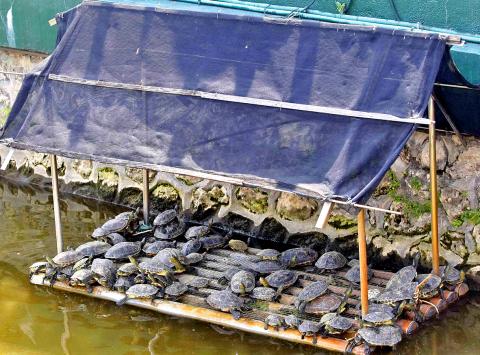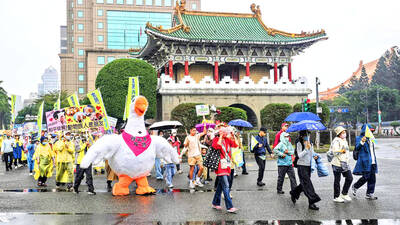Warm winds blowing down from the Central Mountain Range caused the temperature in Greater Kaohsiung to reach 37.6°C before noon yesterday, the highest temperature recorded since the observation station in Kaohsiung was established in 1932.
Statistics from the Central Weather Bureau (CWB) showed the new record was set at 11:49am. Previously, the highest temperature in the city was recorded on June 22, 1980, with the mercury climbing to 37.2°C.
Meanwhile, the temperature in Shinwu Township (新屋) in Taoyuan County reached 37.9°C yesterday, the highest temperature ever recorded in the county. Prior to yesterday, the highest temperature recorded in the town was 36.6°C, which was on July 21 this year.

Photo: CNA
The temperature in Hsinchu reached 37.5°C, and that in Greater Taichung and New Taipei City’s Banciao District (板橋) was 36.5°C and 36.3°C respectively.
The observation center in Chiayi recorded a temperature of 35.5°C yesterday afternoon, the highest seen in September since the center was built in 1968.
The unusual jump in temperature caused bureau forecaster Cheng Ming-dean (鄭明典) to comment on his Facebook page that he had never seen such a “purple” Taiwan in September. Purple is the color used by the bureau to mark an area with a temperature of more than 36°C. Cheng said last week that there is a chance that the high temperatures of this month could set a new national record.
Forecaster Lin Jhih-hui (林智暉) said the nation experienced wind from the east yesterday because Typhoon Kalmaegi was passing near the coast of southern Taiwan. A dry, warm, down-slope wind was created when this wind blew over the Central Mountain Range, causing a rise in temperature.
Former director of the bureau’s forecast center Daniel Wu (吳德榮) said the wind from the east prevented humidity from the ocean, that typically makes landfall before noon, from blowing onshore.
“In Taiwan, extremely high temperatures occur if there is a typhoon near the nation which causes an apparent change in the direction of the wind. The phenomenon, known as a ‘foehn wind,’ happens in places that are on the leeward side of a mountain,” Wu said.
According to the bureau’s weekly forecast, temperatures are to drop slightly after Friday, when high temperatures are likely to drop to 29°C because of rain.
Today, the bureau forecast that showers or thundershowers would be seen in the nation’s southeastern and southern regions. Cloudy to sunny weather is forecast for the rest of the nation.

NUMBERS IMBALANCE: More than 4 million Taiwanese have visited China this year, while only about half a million Chinese have visited here Beijing has yet to respond to Taiwan’s requests for negotiation over matters related to the recovery of cross-strait tourism, the Tourism Administration said yesterday. Taiwan’s tourism authority issued the statement after Chinese-language daily the China Times reported yesterday that the government’s policy of banning group tours to China does not stop Taiwanese from visiting the country. As of October, more than 4.2 million had traveled to China this year, exceeding last year. Beijing estimated the number of Taiwanese tourists in China could reach 4.5 million this year. By contrast, only 500,000 Chinese tourists are expected in Taiwan, the report said. The report

Temperatures are forecast to drop steadily as a continental cold air mass moves across Taiwan, with some areas also likely to see heavy rainfall, the Central Weather Administration (CWA) said. From today through early tomorrow, a cold air mass would keep temperatures low across central and northern Taiwan, and the eastern half of Taiwan proper, with isolated brief showers forecast along Keelung’s north coast, Taipei and New Taipei City’s mountainous areas and eastern Taiwan, it said. Lows of 11°C to 15°C are forecast in central and northern Taiwan, Yilan County, and the outlying Kinmen and Lienchiang (Matsu) counties, and 14°C to 17°C

STEERING FAILURE: The first boat of its class is experiencing teething issues as it readies for acceptance by the navy, according to a recent story about rudder failure The Hai Kun (海鯤), the nation’s first locally built submarine, allegedly suffered a total failure of stern hydraulic systems during the second round of sea acceptance trials on June 26, and sailors were forced to manually operate the X-rudder to turn the submarine and return to port, news Web site Mirror Daily reported yesterday. The report said that tugboats following the Hai Kun assisted the submarine in avoiding collisions with other ships due to the X-rudder malfunctioning. At the time of the report, the submarine had completed its trials and was scheduled to begin diving and surfacing tests in shallow areas. The X-rudder,

DEMAND: The government should enact regulations in line with Austria and Germany to incorporate vegan nutrition into school meals, an advocate said More than 1,000 people yesterday marched in Taipei to promote veganism, calling for legislation to incorporate vegan diets into school lunches and the national net zero emissions program. Participants gathered on Ketagalan Boulevard in front of the Presidential Office Building for the march, which was organized by the Vegan Action Network (VAN). Former ambassador to Chad Chiu Chung-jen (邱仲仁), actor Yankee Yang (楊子儀) and actress Cindy Lien (連俞涵) attended the event. VAN member Marianne Chao (趙梅君) said that the campaign aimed to urge the government to promote vegan diets across schools and government agencies via legislation and national policies, which would help build